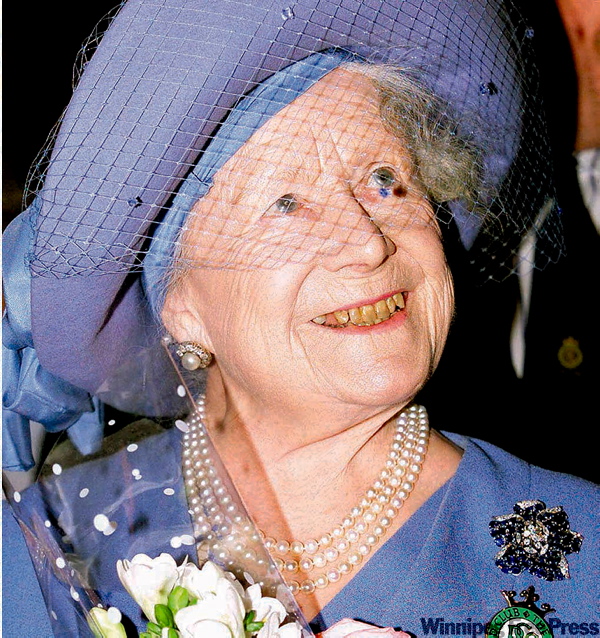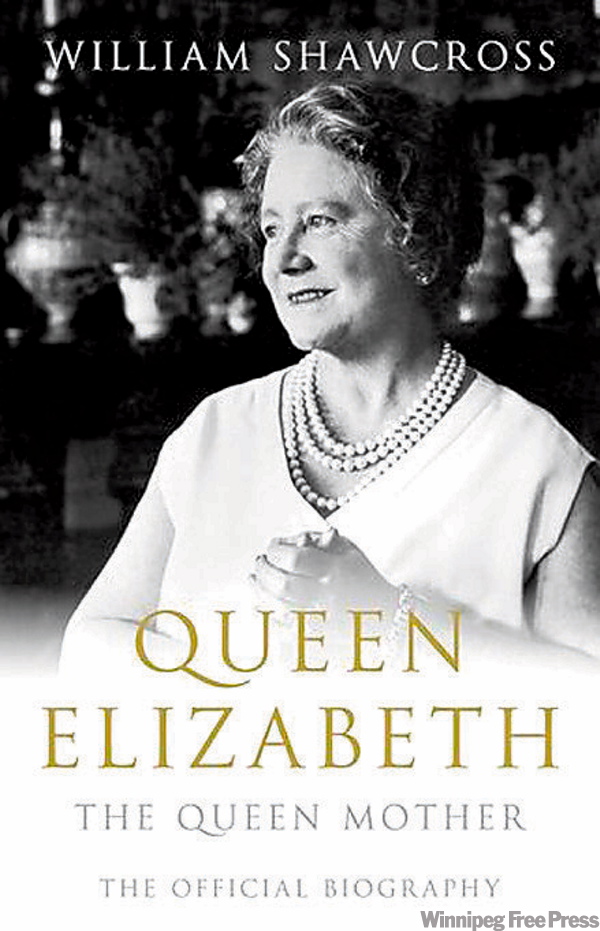Queen mum remained popular throughout her dignified royal life
Advertisement
Read this article for free:
or
Already have an account? Log in here »
To continue reading, please subscribe:
Monthly Digital Subscription
$0 for the first 4 weeks*
- Enjoy unlimited reading on winnipegfreepress.com
- Read the E-Edition, our digital replica newspaper
- Access News Break, our award-winning app
- Play interactive puzzles
*No charge for 4 weeks then price increases to the regular rate of $19.00 plus GST every four weeks. Offer available to new and qualified returning subscribers only. Cancel any time.
Monthly Digital Subscription
$4.75/week*
- Enjoy unlimited reading on winnipegfreepress.com
- Read the E-Edition, our digital replica newspaper
- Access News Break, our award-winning app
- Play interactive puzzles
*Billed as $19 plus GST every four weeks. Cancel any time.
To continue reading, please subscribe:
Add Free Press access to your Brandon Sun subscription for only an additional
$1 for the first 4 weeks*
*Your next subscription payment will increase by $1.00 and you will be charged $16.99 plus GST for four weeks. After four weeks, your payment will increase to $23.99 plus GST every four weeks.
Read unlimited articles for free today:
or
Already have an account? Log in here »
Hey there, time traveller!
This article was published 28/11/2009 (5823 days ago), so information in it may no longer be current.
Queen Elizabeth
The Queen Mother — The Official Biography
By William Shawcross

HarperCollins, 1,096 pages $40
During the Blitz, the late Queen Mother fully lived up to her reputation for concern when she apparently said, following the bombing of Buckingham Palace, "Now I can look the East End in the face."
Surprisingly, the author of this massive biography, an expert on all things royal, suggests that the remark may be apocryphal.
William Shawcross is a professional historian, with a long list of credits. He produced a TV documentary on the Royal Family in 1995 which may have been the primary reason Queen Elizabeth II asked him to take on this job. It took him six years.
He has produced a thorough (of course, in 1,096 pages he should be thorough), engaging piece of work which will please many.
But be warned. It doesn’t cover everything well, and physically, it takes a lot to read and lug around. His sections on Canada are good.
Some will inevitably wonder whether "official" is an excuse for concealing things. For example, we notice that the Queen Mother is seldom mentioned in connection with Princess Di, even though Diana herself referred in various places to her husband’s grandmother staring at her with hatred as her marriage to Prince Charles deteriorated.
But Shawcross has done a masterful job in bringing all the threads together, including the inevitable horse-racing and bridge tables.
Elizabeth Angela Marguerite Bowes Lyon ("the Queen mum" for short,) was born in 1900, in the declining months of Queen Victoria’s reign and died on Easter Saturday in 2002. She was one of the most popular women in the world in her day, out-polling nearly all the members of her own family.
A younger daughter of a Scottish earl, she entered the British royal family in 1923 when she married the shy, speech-challenged Duke of York, who became King George VI in 1936 following the abdication of his feckless brother, King Edward VIII.
She won a personal following because of her charm, her memory for faces and names, her compassion, her profound sense of duty and her frequent eccentricity. For example, she took solace herself on many an occasion by imbibing huge quantities of gin and tonic. (Living to be 100 helped her popularity, too.)
She was a significant player in constitutional and, within limits, political circles resulting from her high profile. Of course, she had no formal personal role resulting from the constitution.
What influence she had stemmed from her relationship with her husband. Her title of Queen Mother throughout her 50-year widowhood was devised by herself to distinguish her from her daughter, Queen Elizabeth II.

She had no wish to be saddled with some such frumpy title as Queen Dowager.
But at the king’s side, she strengthened his resolve, and added to the monarchy’s standing. In 1936, though both were reluctant to depart from their simple, fulfilling family life to assume the throne, she kept her husband focused on preparation for kingship. In 1939, she was a triumphant success during the royal visit to Canada and the U.S.
She also showed a great deal of wisdom and foresight in trying to brake the royal family’s rush, in the mid-1970s and beyond, into the arms of the popularizers and modernizers.
In light of the recent visit to Canada of the Prince of Wales and his Duchess, one has to ask whether the monarchy should be retained here, and what role the Queen Mother has played in its survival to this point.
The second question will go first. Her role was undoubtedly substantial. She seemed to lift the Windsor dynasty out of its cocoon of pomposity, occasional slapstick and lowbrow antics. Not that the Queen Mother was an especially cultured person. But she maintained her dignity. Some others did not.
The future of the monarchy is hard to chart. It is commonly agreed that the present monarch, "tough as a yak," according to some courtiers, will be our head of state until she dies. Charles excites indifference. William excites young girls.
The institution of monarchy is embedded in our system and will be hard to replace, although (and this is the point), its survival would be helped by the presence of another Queen Mother.
Geoff Lambert is a political scientist at St. Paul’s College at the University of Manitoba.

